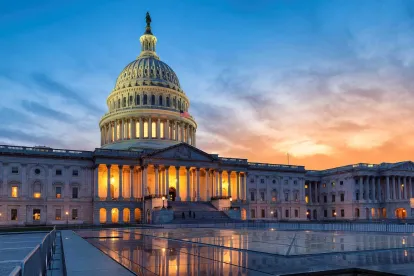117th Congress Works on Last-Minute Bills as Holidays Loom. Nothing is more typical of the holiday season in Washington, D.C., than a last-minute legislative crisis in the U.S. Congress, and this year is no different. With just hours to go before funding for the federal government expired, Congress passed a weeklong legislative reprieve extending the deadline to December 23, 2022. Hopefully, this is a technicality and an effort to buy time to sort out the legislative details, as Democrats and Republicans have reportedly agreed to a funding deal with a top-line figure of around $1.7 trillion. Employee benefits watchers are monitoring the negotiations to see if SECURE 2.0, a package of multiple bills that would make it easier for individuals to save for retirement, will be included in the final bill. (If enacted, the package would be the first major retirement savings legislation since the Setting Every Community Up for Retirement Enhancement (SECURE) Act became law in 2019.) Finally, on December 15, the U.S. Senate gave final approval to the National Defense Authorization Act for Fiscal Year 2023 and sent the $858 billion military policy bill to the president for his signature.
NLRB Resuscitates Gerrymandered Bargaining Unit Standard. On December 14, 2022, the National Labor Relations Board (NLRB) issued a decision returning to its 2011 Specialty Healthcare standard for determining the appropriateness of petitioned-for bargaining units. Under this standard, labor unions’ petitioned-for units are presumptively appropriate, and excluded employees must have an “overwhelming community of interest” in order to be included in the unit. Dissenting members John F. Ring and Marvin E. Kaplan argued that, for the Board majority, “the primary goal of a unit determination is to facilitate employees’ ability to organize in the unit selected by the petitioning union.” Ring and Kaplan are definitely on to something, as the decision will essentially allow unions to draw bargaining unit lines around workers that support the union, which could lead to the fragmentation of the workplace.
NLRB Expands Damages Remedy. On December 13, 2022, the NLRB issued a decision expanding the types of monetary penalties available for employees who are victims of unfair labor practices. While such damages are often characterized as “consequential damages,” the Board majority argued that it is more appropriate to consider such awards as within the Board’s authority to grant make-whole relief:
We conclude that in all cases in which our standard remedy would include an order for make-whole relief, the Board will expressly order that the respondent compensate affected employees for all direct or foreseeable pecuniary harms suffered as a result of the respondent’s unfair labor practice.
While the majority declined to enumerate the types of pecuniary harms that may be covered under the new standard, such costs could include “out-of-pocket medical expenses, credit card debt, or other costs simply in order to make ends meet.”
Dissenting members Ring and Kaplan argued that while employees should be compensated for all losses that are a direct result of the employer’s unfair labor practice, the Board’s new standard “would permit recovery for any losses indirectly caused by an unfair labor practice, regardless of how long the chain of causation may stretch from unfair labor practice to loss, whenever the loss is found to be foreseeable.” Ring and Kaplan wrote that “this standard opens the door to awards of speculative damages that go beyond the Board’s remedial authority.” The dissent further argued that this standard would lead to burdensome and “time-consuming” compliance proceedings. The Board will apply the new policy retroactively, in “all pending cases in whatever stage.”
C. Thomas Davis and Zachary V. Zagger have additional analysis.
Ring Exits. The Board decisions discussed above are unlikely to be the last precedent-changing decisions we will see from the Board in the near future. Member John F. Ring’s term came to a close on December 16, 2022, and there is usually a flurry of case decisions issued on or around the end of a Board member’s term. Ring was sworn in as chair of the Board in April 2018, a position he held until January 20, 2021, and he remained a Board member. Ring’s efforts to rebalance the labor policy landscape while chair are too numerous to list, but they include the issuance of the Board’s current joint-employer regulation (which the new majority is currently attempting to undo) and the employee-choice regulation (which the new majority is also currently attempting to undo). Member Ring helped restore the Board’s long-standing test for independent contractor status (again, which the new majority is currently attempting to undo), made commonsense changes to the Board’s 2015 election regulations, and clarified employer property rights.
DOL Independent Contractor Proposal Moves Forward. The public comment docket closed this week on the U.S. Department of Labor’s (DOL) proposed regulation that would implement a new independent contractor standard under the Fair Labor Standards Act (FLSA). Among the groups filing comments was the National Retail Federation, which wrote:
Rather, the proposed rule accomplishes little for the American economy, for business or for millions of entrepreneurial individuals. It will jettison the DOL’s 2021 Rule “Independent Contractor Status Under the Fair Labor Standards Act (“the Current Rule”) that clearly defines the difference between employees and independent contractors. It is improperly skewed toward a finding of employment status, even when a worker is a bona fide independent contractor engaged in a business-to-business relationship based on economic reality. It will add unnecessary confusion to businesses’ operations, discourage innovation, increase costs across all industries and further drive up already rampant inflation. Finally, it will cause significant economic upheaval for both the millions of entrepreneurial individuals who currently choose to manage their own businesses through independent contractor arrangements and for the businesses across the economy that rely on these entrepreneurs for their expertise.
The closing of the public comment docket puts the DOL on target to finalize the rule sometime in the second half of 2023.
Remembering Don Young. This week, the U.S. Senate passed the Don Young Recognition Act (S.5066) to honor the late representative from Alaska. Young died in March 2022 at the age of eighty-eight after representing Alaska—which has only one at-large seat in the U.S. House of Representatives—for forty-nine years. The bill designates “the 2,598-foot volcanic peak known as ‘Mount Cerberus’ located at 51.93569°N, 179.5848°E, on Semisopochnoi Island in the State of Alaska as ‘Mount Young.’” Naming a volcano after Young is particularly appropriate, given the late congressman’s reputedly fiery temper.




 />i
/>i


